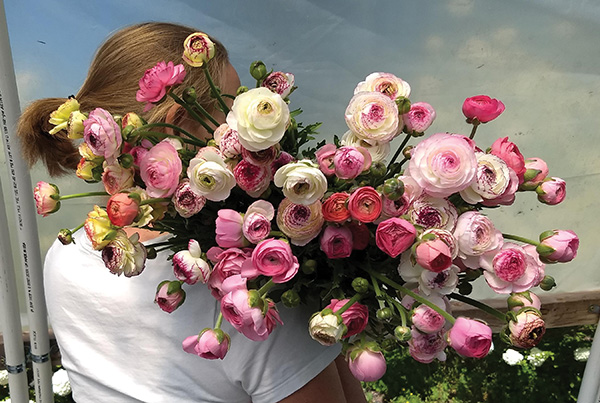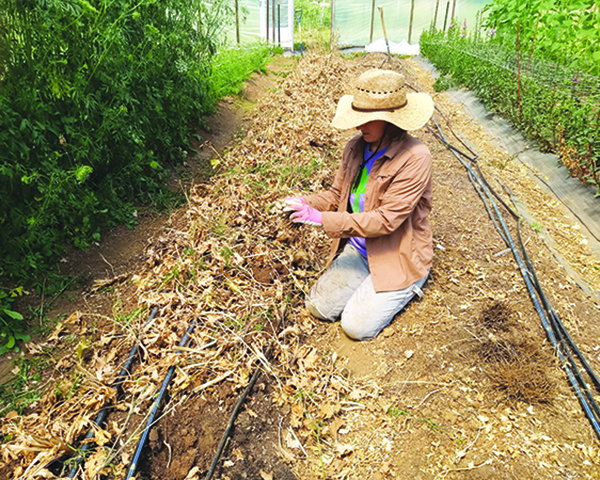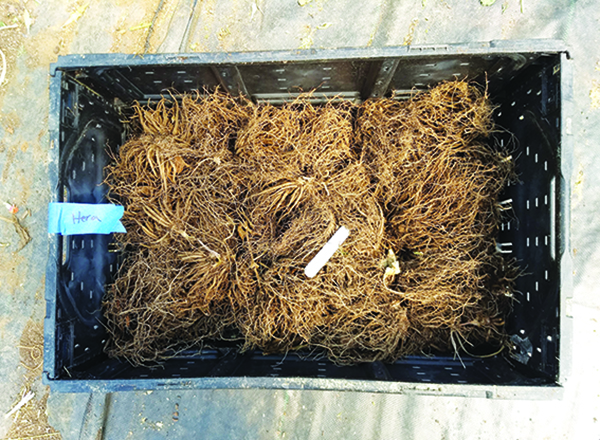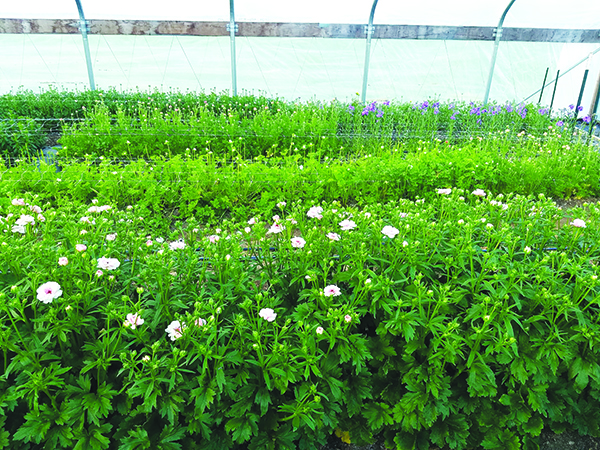Growing, harvesting, postharvest handling, and saving corms
This is the second article in a two-part series on growing anemones and ranunculus. The first, which ran in the September 2021 GFM, covers ordering corms, soaking, pre-sprouting, and transplanting. This article appeared in the Nov/Dec 2021 issue of Growing for Market Magazine.
Growing your plants
Once anemones and ranunculus have started to grow, they are quite cold hardy as long as the ground doesn’t freeze. We leave them uncovered on all but the coldest nights to minimize disease. Under two layers of row cover, they have survived air temperatures of 5°F in our high tunnel.
 These La Belle ranunculus are the first to bloom.
These La Belle ranunculus are the first to bloom.
Rather than cold, we have found managing water, disease, and pests to be the main challenges. Pests and disease can show up suddenly and quickly spiral out of control in high-density hoop house plantings. So, we recommend making a plan for prevention and mitigation and being ready to tackle these challenges before they show up.
Watering
Once the plants have sprouted, we keep the soil barely moist until the plants are actively growing. We test this by sticking our finger all the way into the ground. We only water if it emerges with no soil stuck to it. I asked Dave Dowling, formerly a cut flower farmer and now a sales representative for Ball ColorLink, about common rookie mistakes made growing anemones and ranunculus; water management topped his list.
 Harvesting Butterfly Ranunculus corms after the leaves have mostly died back and the bed has been loosened with a digging fork.
Harvesting Butterfly Ranunculus corms after the leaves have mostly died back and the bed has been loosened with a digging fork.
“Overwatering plants that don’t need water yet is probably the biggest mistake new growers make,” Dowling replied. “Soak, pre-sprout, and plant. Water once, then walk away. No more water unless the soil is bone dry, then water lightly if needed. Once plants have foliage to use the water, water more, but still lightly until they are large enough to use a full, deep watering. Once flower buds and stems are forming, make sure they are watered enough. At that point, lack of water will reduce yield and result in smaller flowers.”
We have also found that uneven watering contributes to split stems in anemones. Basically, anything that causes a spurt of growth can cause stems to split, like a deep watering after drying out, overzealous fertilizer application, or a warm sunny day after a cloudy week. While this is annoying, it resolves itself once the stimulus is over. You can’t do anything about the weather, but you can recognize if you caused the problem and manage water and fertility better in the future.
Disease
Anemones and ranunculus are highly susceptible to fungal diseases. For this reason, it is important to manage moisture and humidity carefully. We use row cover rarely — only on very cold nights or when we are protecting buds from frost — and we remove it and ventilate the hoop house as early as possible each day. When we irrigate or spray, we do it early in the morning and only on warm days when the hoop house will be open. With careful water management, we have mostly avoided outbreaks of botrytis and root rots. Nevertheless, our ranunculus usually does get powdery mildew toward the end of the season. Use your preferred methods for preventing and treating powdery mildew.
 We wash ranunculus corms and let them air dry before storage.
We wash ranunculus corms and let them air dry before storage.
Pests
Our main insect pests are aphids and thrips, and in the hoop house they show up quite early. Cutting back on nitrogen has helped reduce insect pressure, and we also use a variety of sprays to help control them. We have found Pyganic, AzaGuard, and BotaniGard all to be effective. If you choose to spray, spray very carefully. We have learned the hard way that delicate anemone and ranunculus petals easily suffer mechanical damage from sprayers. Finally, although we haven’t had trouble with mice and voles, we understand from other growers they can quickly devour your corms.
Keep them happy: As the weather warms, your plants will start actively growing and form a healthy canopy of leaves. At this point, they will need more water and also more fertility. You can fertigate, side-dress, or foliar feed, just be careful not to damage the blossoms if you spray. Inadequate ongoing fertility is another common mistake growers make, according to Dowling.
It is also important to help keep soil cool. Some people use light organic mulches to accomplish this, although we do not due to concerns about slugs and moisture. Instead, we rely on dense plantings and narrow paths to shade the soil. Dowling also recommends aggressively ventilating your tunnel. “Make sure to vent the tunnel in the spring 24/7 once nighttime temps are above 35°F. Keeping the soil cool keeps them blooming longer.”
Harvest and post-harvest
As with all flowers, anemones and ranunculus will only realize their full potential if they are harvested at the right time and properly handled after harvest. This is worth the effort, because these flowers will reward you with a long vase life and very happy customers. One important trick is to harvest both anemones and ranunculus early in the morning. Both flowers close up at night, and they are much less prone to physical damage if the flowers are still closed when you harvest.
Below is a lot of information about the proper stage of harvest, potential vase life, and storage methods. We share what we do, but we strongly recommend you conduct your own trials. You should cut anemones and ranunculus at a variety of stages and watch them open so you know how much flexibility you have when the weather or your schedule requires it.
You should also conduct your own storage and vase life trials. Stage of harvest, post-harvest practices, water quality, the cooler, and many other factors can affect flower quality. This is what we have learned based on our own experience, but you should determine what works for you on your farm. For more on the post harvest handling of flowers, read the article “Cater to the special needs of flowers at harvest” by Gretel Adams at growingformarket.com or in the March 2016 issue of GFM.
Anemone harvest
It can take some practice to recognize the right stage for harvesting anemones. You can focus on the petals, waiting for them to be completely colored, full, and loose looking. We prefer to focus on the peduncle, the small section of stem between the flower and the collar of foliage. We like to harvest when it is ¼ to ½ inch long. Once it reaches an inch, or once the flowers no longer close at night or are shedding pollen, the flower is too far gone and must be deadheaded.
 Washed and dried corms of Butterfly Ranunculus ready for storage. All images courtesy of the author.
Washed and dried corms of Butterfly Ranunculus ready for storage. All images courtesy of the author.
We cut and store our anemones in plain water in clean buckets. We will store our anemones for up to seven days in our 36°F cooler, 10 days if we know they are going to be used for an event where vase life isn’t critical. We expect their vase life to be about one week. We find that anemone stems will bend in the bucket if they are leaning in any way, so it is best to store them bolt upright in full buckets. Finally, anemones continue to elongate in the vase, much like tulips. If you are using anemones in an arrangement, tuck them in a little lower than you would other flowers.
Ranunculus harvest
Ranunculus can be picked at a variety of stages depending on your market. For our wholesale customers, we pick them as soon as they feel soft all the way through, like a marshmallow. For retail, you might want to pick them after they have opened once or twice and appear loose in the morning. If you go to pick them in the morning and they are completely open, you have waited too long and you should bring that flower in to enjoy yourself. Butterfly Ranunculus are ready when one to three flowers on the spray are open.
We pick our ranunculus into a hydrating solution, and store and deliver them in either holding solution or flower food, depending on if we want them to keep opening or not. Ranunculus has an excellent vase life, at least 10 to 14 days. Ranunculus holds very well in the cooler. Although we sell most of our ranunculus within a week of harvest, we have rarely held them for as long as four weeks for a customer who especially requested we do so for an event.
This is pushing it, however, and their vase life would only be a few days at most. To do this, your cooler must be very cold and the flowers must be absolutely dry when they go into the cooler or they will get moldy. Butterfly Ranunculus have a waxy coating on the petals which helps keep them fresh- they can be stored for three weeks and still have an acceptable vase life, though the color will fade.
Terminating, saving, and preparing for next year
By the time your anemones and ranunculus are done blooming, it is time to be thinking about next year’s crop. This is when you should be placing orders for any corms that you will be purchasing. (See part one of this series for information on our favorite varieties and where to buy them.)
For those who are interested, it is also possible to save ranunculus corms. We tried saving anemone corms, but they became woody with many hollow spots and did not produce well. We no longer save our anemone corms. Dowling says that it can be done. “Although they seem to save better when they are left in the ground in the tunnel,” he said. “Growers sometimes grow a crop of celosia over them, planting in between the anemones. The celosia needs to be cut at the ground to remove them at the end of the season, not pulled. If they are dug and saved, they need to be dried, and then stored warm and dry in the house at 60 to 70°F Barns may get too hot for storage. Paper lunch bags work good for storage.”
Saving ranunculus corms is straightforward but somewhat labor intensive. The main benefits: Larger corms produce larger and more abundant flowers. Diversifying your corm supply increases your security. Premium corms are expensive and saving them can reduce your expenses if it is allowed for that variety.
Just remember that cloned corms may be protected and it may be against the rules to save them. Butterfly and romance ranunculus may be saved, but the breeder is owed the same royalty on saved corms as on new ones. This still reduces the cost of the corms significantly. Plant breeders invest a lot of time and money in bringing these wonderful varieties to market. Saving protected plants robs the breeders and it is important that we respect their past work and support their future efforts by following the protection rules for each variety. After all, we want them to continue to bring new and wonderful varieties to market for us to grow. Your bulb supplier can help you determine what restrictions are in place for any corms you wish to save.
 We grow anemones and ranunculus in our unheated hoop house. In front is butterfly ranunculus, middle are anemones, rear is ranunculus and stock
We grow anemones and ranunculus in our unheated hoop house. In front is butterfly ranunculus, middle are anemones, rear is ranunculus and stock
If you are not saving your corms, it is important to kill them, either by tillage or by physically removing them from the bed. Anemones and ranunculus corms can go dormant in the summer and then return in the winter, becoming a beautiful weed problem. In no-till systems such as ours, pulling the corms is the only way to terminate them, so saving them becomes a more attractive option since part of the work would have to be done whether we were saving them or not.
Steps to save ranunculus corms
1. As soon as you are done harvesting a bed, turn off the irrigation. You want the corms to enter their dormant state and dry down, much as they would in the arid Mediterranean summers.
2. The leaves will turn yellow and then brown. Before the leaves have completely withered away, use them to help you pull up the corms. You may need to fork the bed to loosen very large corms, such as on butterfly ranunculus. Remove the foliage. It should break away relatively easily. Put each variety in its own container, discarding any moldy, tiny, or unhealthy looking corms. From now on, take extra care to make sure each variety is properly labeled and separated, since they are impossible to tell apart at this stage.
3. At this point, we wash the dirt out of the corms using a garden hose, although not all farmers do this. We think that this step helps them store better and, more importantly, helps prevent disease in the rehydration process.
4. Allow corms to dry and cure in a single layer for 12 to 24 hours.
5. Store your corms in a paper or mesh bag in a warm, dry place. We store ours in mesh bags hanging in our tobacco barn. Paper bags in a closet in your house would be fine.
6. Corms can be divided at any point in this process. We divide our corms before we soak them because we think they are easier to divide once they are dried and have shrunk away from each other. To divide, we look for large corms with multiple centers that wiggle independently from each other. If they seem solidly attached, they haven’t split yet and we wait another year.
While corms are easy to save, you are not guaranteed success. You may experience a loss of a variety, vigor may decline over time, or colors may drift and you may end up with something unexpected. Of course, we also have been stymied when a variety that we ordered from the supplier wasn’t delivered without notice, leaving us scrambling. We don’t recommend you save 100 percent of your corms. We save about half of our ranunculus every year, diversifying our supply chain for security while also saving money. We also recommend you start by saving only a couple varieties to see if it is worth the extra work for your farm and situation.
Anemones and ranunculus are popular early season flowers that can improve profitability and cash flow on your farm. Because of the cost of corms, need for protection, and reputation for being disease prone, many beginning farmers find them intimidating to grow. After reading this, I hope that you will try adding anemones and ranunculus to your farm.
Jonathan and Megan Leiss grow half an acre of no-till flowers on their homestead, Spring Forth Farm, in Hurdle Mills, NC. Megan and Jonathan’s course, The No-Till Micro-Scale Flower Farm is available from The Gardener’s Workshop: www.thegardenersworkshop.com.

